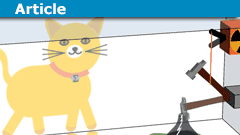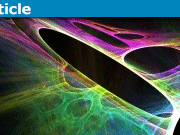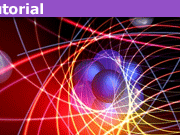Schrödinger’s Cat and the Qbit
The concept of quantum superposition (or superposition for short) is very counterintuitive, as Schr##\ddot{\text{o}}##dinger noted in 1935 writing [1], “One can even set up quite ridiculous cases.” To make his point, he assumed a cat was closed out of sight in a box with a radioactive material that would decay with 50% probability within an hour. If a radioactive decay occurred, a deadly gas would be released in the box killing the cat. Since the decay was represented by a quantum wavefunction in a superposition of 50% “yes” and 50% “no” regarding the decay after one hour, the cat was also represented by a quantum wavefunction in a superposition of 50% “alive” and 50% “dead” (Figure 1). Schr##\ddot{\text{o}}##dinger wrote [1]:
The wavefunction of the entire system would express this by having in it the living and dead cat (pardon the expression) mixed or smeared out in equal parts.
This has become known as Schr##\ddot{\text{o}}##dinger’s Cat.

Figure 1 (taken from [2])
This is usually where the introduction of superposition via Schr##\ddot{\text{o}}##dinger’s Cat ends, but it doesn’t fully capture the weirdness of superposition. What’s the difference between superposition and simple ignorance about the state of the cat hidden from sight inside the box? What if my cat-killing trigger was classical instead of quantum, would that somehow change the situation from superposition to simple ignorance about the state of the cat? Suppose I give you a ride home and watch you until you disappear into your house. At that instant there is some non-zero probability that you will drop dead of a stroke while out of my sight. Does that mean you’re in a superposition of “alive” and “dead” like Schr##\ddot{\text{o}}##dinger’s Cat?
Let me answer this as a quantum information theorist might [2]. The smallest piece or bit of information is obtained from a measurement with a binary outcome. Therefore, measuring the cat and finding it is either “alive” or “dead” constitutes a bit of information. If the cat is definitely in one state or the other inside the box and we’re just opening the box to find out which it is, then we have a classical bit of information (Cbit). If, on the other hand, the cat is truly in a superposition of “alive” and “dead”, then we have a quantum bit of information (qubit or Qbit). Let explain the difference between a Cbit and a Qbit and let you decide.
In the lingo of quantum information theory, you can get from a pure state to another pure state continuously through other pure states for a Qbit, while you are only passing through mixed states between pure states for the Cbit. As Hardy pointed out in Quantum Theory From Five Reasonable Axioms:
Axiom 5 (which requires that there exists continuous reversible transformations between pure states) rules out classical probability theory. If Axiom 5 (or even just the word “continuous” from Axiom 5) is dropped then we obtain classical probability theory instead.
Now let me explain what that means.
Suppose your Cbit is a box and a measurement of the box (opening it) reveals one of two outcomes: a ball (yes) or no ball (no). The probability space has two axes, one represents “yes” and the other “no”. Those are pure states, i.e., they represent actual measurement outcomes of a single trial of the experiment. Any state between those pure states, e.g., 80% yes and 20% no, does not represent the outcome of some new measurement, it represents a distribution of the yes-no outcomes of the original measurement, i.e., it’s a mixed state. But, if the ball-box combo was a Qbit, then that 80-20 state would have to correspond to the outcome of some other measurement with 100% probability.
For example, consider the Qbit for electron spin. When you send electrons through a North-South magnetic field the electrons are deflected an equal degree towards the North pole (called spin “up”) or the South pole (called spin “down”). Suppose your N-S magnetic field is vertically oriented (along the z axis) and 50% of your electrons are deflected up (“up” towards the North pole) and 50% are deflected down (“down” towards the South pole) (Figure 2).

Figure 2 (taken from [2])
The corresponding quantum z-spin state is $$|\psi\rangle = \frac{|\text{z+}\rangle + |\text{z-}\rangle}{\sqrt{2}}$$ It means you will get 50% “up” results and 50% “down” results when you make a z-spin measurement of electrons in this state. Since this is a Qbit, your electron state must also be a pure state for some measurement corresponding to an outcome with 100% probability. What is that measurement and its outcome in this case? An x-spin “up” state works. In other words, if you first pass electrons through horizontally oriented magnets (rotate North pole ##90^\circ## to x direction in Figure 2) and let those electrons that are deflected right (“up” towards the North magnetic pole) be the Source for the vertically oriented magnets in Figure 2, then 50% will be deflected “up” (literally up for the magnets in Figure 2) and 50% will be deflected “down” (literally down). That is what it means to say your 50-50 z-spin electrons are 100-0 x-spin electrons. In quantum mechanics we write $$|\psi\rangle =|\text{x+}\rangle = \frac{|\text{z+}\rangle + |\text{z-}\rangle}{\sqrt{2}}$$ So, if you measure ##|\psi\rangle## in the z direction, you get 50% “up” and 50% “down” electrons (half of the electrons are deflected up and half are deflected down), but if you measure that same ##|\psi\rangle## in the x direction, you get 100% “up” electrons (all of the electrons are deflected to the right). Now you understand the physical difference between a Cbit and a Qbit.
The problem with the way most people present Schr##\ddot{\text{o}}##dinger’s Cat is that they only talk about a measurement with outcomes of Live Cat (LC) and Dead Cat (DC). Given only that information we could have a Cbit, i.e., no superposition. The problem Schr##\ddot{\text{o}}##dinger was pointing out is that quantum mechanics is supposedly applicable to anything. Therefore, it should be possible to render the Cat-Box system a Qbit rather than a Cbit in which case the state $$|\psi\rangle = \frac{|\text{LC}\rangle + |\text{DC}\rangle}{\sqrt{2}}$$ must represent the outcome of some measurement with 100% certainty. What is that measurement? And, what does its outcome mean physically? Is the Cat-Box system a Qbit simply because of its quantum trigger mechanism for the deadly gas? Does that help answer the questions we need answered to understand the Cat-Box system as a Qbit? We could answer those questions for the spin of an electron, but his point was we have no answers for the Cat-Box system. So, is quantum mechanics really applicable to any thing? Is Schr##\ddot{\text{o}}##dinger’s Cat a Qbit or a Cbit?
- E. SCHRÖDINGER, The present situation in quantum mechanics, Naturwissenschaften, 23 (1935), p. 807–812.
- W.M. Stuckey, Michael Silberstein, and Timothy McDevitt, “Einstein’s Entanglement: Bell Inequalities, Relativity, and the Qubit” (Oxford UP, 2024).
PhD in general relativity (1987), researching foundations of physics since 1994. Coauthor of “Beyond the Dynamical Universe” (Oxford UP, 2018).










As an approximation for analyzing particular experiments, this can work ok–basically you are ignoring all the other degrees of freedom of the particular system (buckyball, silver atom in an S-G experiment, etc.) because you have set up the experiment so those degrees of freedom, to a good enough approximation, do not affect the outcome.
However, if we're talking about a thought experiment like Schrodinger's cat, we're not talking about experimental approximations, we're talking about foundations of QM. And as far as foundations of QM are concerned, a buckyball is not a qubit, nor is a silver atom. For foundational purposes you simply can't ignore all the additional complexity. I thought we had agreed that that was part of Schrodinger's point.
"
In the reconstruction of QM via information-theoretic principles there is an axiom that states any subspace can be explored independently of the rest. Another axiom states that all subspaces of the same dimension have the same quantum probability structure. So, regardless of what the 2-dim subspace is part of and regardless of what physical situation is responsible for it, when you probe that subspace alone you have a qubit. Let's use this in a pretend situation analogous to Schrodinger's Cat.
Stern and Gerlach tell us that they have a measurement in which a silver atom acted like a qubit (they didn't know about spin, even after they had their result they thought they were exploring the orbital angular momentum of the valence electron). They said that when they passed silver atoms through an inhomogeneous magnetic field, half the time the atoms were deflected up towards the North magnetic pole and half the time they were deflected down towards the South magnetic pole. We're skeptical that they have a qubit with its complementarity from superposition because a silver atom has 47 electrons and a mass number of 108. It seems much more likely that they have only instantiated a Cbit, so we ask them to describe complementary measurements to verify they truly have 2-dim Hilbert subspace behavior, i.e., a qubit.
They answer that when they send atoms first deflected up from vertically-oriented magnets to another pair of vertically-oriented magnets, the atoms are deflected up 100% of the time. And, when they send them to horizontally-oriented magnets, half are deflected left and half are deflected right. Therefore, |V+> = |H+> + |H-> as required of a qubit. We agree they do have an example of superposition via the qubit!
So, by analogy, I'm simply asking those who claim Schrodinger's Cat is an example of superposition to pony up a measurement and outcome complementary to "open the box" and Live Cat or Dead Cat.
[Aside: I'm ignoring the requirement of *continuously* reversible transformations between pure states for simplicity, since I've yet to see complementarity alone for Schrodinger's Cat.]
Anything with a 2-dim Hilbert space is a qubit
"
As an approximation for analyzing particular experiments, this can work ok–basically you are ignoring all the other degrees of freedom of the particular system (buckyball, silver atom in an S-G experiment, etc.) because you have set up the experiment so those degrees of freedom, to a good enough approximation, do not affect the outcome.
However, if we're talking about a thought experiment like Schrodinger's cat, we're not talking about experimental approximations, we're talking about foundations of QM. And as far as foundations of QM are concerned, a buckyball is not a qubit, nor is a silver atom. For foundational purposes you simply can't ignore all the additional complexity. I thought we had agreed that that was part of Schrodinger's point.
You seem to be using the term "quanta" in an unusual way:
They have done double slit experiments showing interference using 60-atom buckyballs, but that doesn't mean buckyballs are qubits or that they are elementary quantum systems with no subsystems, which are the two senses in which I'm used to seeing the word "quanta" used.
"
Anything with a 2-dim Hilbert space is a qubit and any quantum in a double-slit experiment qualifies. The two outcomes for a position measurement in the double-slit experiment are slit 1 or slit 2. [For example, put the detector screen right up against the slits to make the position measurement.] If you're throwing baseballs (classical objects) through the slits, then you have a Cbit and there is no complementary measurement corresponding to slit 1 + slit 2. No matter how far you move the detector screen away from the slits, the baseballs will never start producing an interference pattern. If you have a quantum in the double-slit experiment, then you have a qubit, so there is a measurement with an outcome of slit 1 + slit 2, it's the constructive fringes of your interference pattern giving you a wavelength (lambda) whence momentum = h/lambda. The other momentum outcome is slit 1 – slit 2 corresponding to the destructive fringes. You can get a momentum measurement as the screen gets infinitely far away from the slits, so that the fringes of same order on either side of the center are equal distance from either slit. [Experimentalists typically use a lens such that detector screen locations 2f and f behind the lens give you position and momentum measurements.]
The complexity of the quantum used in the double-slit experiment doesn't matter. The same is true for the Stern-Gerlach experiment where silver atoms become qubits. Send those buckyballs through triple-slits and you have a qutrit. Put an atom in an atomic trap and it's no longer a quantum because it has definite position and momentum. It's exchanging about 100,000 photons per second to become a classical object in that case. It's all context dependent.
QM doesn't place a size limit on quanta
"
You seem to be using the term "quanta" in an unusual way:
"
They have made quanta from 60-atom buckyballs
"
They have done double slit experiments showing interference using 60-atom buckyballs, but that doesn't mean buckyballs are qubits or that they are elementary quantum systems with no subsystems, which are the two senses in which I'm used to seeing the word "quanta" used.
Ah, I see. Your viewpoint would then be similar to that of Schrodinger himself (and to my own), since AFAIK he intended the cat thought experiment as a reductio ad absurdum of the claim that QM could be applied to macroscopic objects as if they were qubits.
"
Exactly, although QM doesn't place a size limit on quanta, so maybe a clever experimentalist will someday create a qubit with one measurement equivalent to "open the box" and two outcomes as complex as Live Cat, Dead Cat. They have made quanta from 60-atom buckyballs, but the cat-box system is many orders of magnitude larger than a buckyball, so I doubt I'll live to see that :-)
If you use Schrodinger's Cat as an example of quantum superposition, then you are claiming it is a qubit
"
Ah, I see. Your viewpoint would then be similar to that of Schrodinger himself (and to my own), since AFAIK he intended the cat thought experiment as a reductio ad absurdum of the claim that QM could be applied to macroscopic objects as if they were qubits.
Well, you're the one who said we can pretend that the cat-box system is a qubit. So the burden is on you to produce such a measurement. If you can't, then maybe you need to rethink your claim that the cat-box system can be treated as a qubit.
"
You missed the point of the Insight. If you use Schrodinger's Cat as an example of quantum superposition, then you are claiming it is a qubit and it is incumbent upon you to come up with that complementary measurement and its outcomes. I don't pretend to know what that measurement and its outcomes are, so I wouldn't use Schrodinger's Cat as an example of quantum superposition or claim it is a qubit myself.
The measurement of the photon in another basis is the measurement of the superposition. If you want to open the box and see an alive+dead cat that is not possible, it is like asking to see both spin up-z and spin down-z with a Stern-Gerlach measurement oriented in z, it is not possible.
"
No, when people use Schrodinger's Cat as a example of superposition, they say the measurement is "open the box" and the outcomes are Live Cat or Dead Cat, so if you want that to be a qubit, then you need a measurement and outcomes equivalent in scale and constituents to "open the box" and Live Cat, Dead Cat. That's the point of the Insight.
In order for the cat-box system to be a qubit (not a simple Cbit), there has to be a "vertical spin" measurement corresponding to its "horizontal spin" representation (where the "horizontal spin" measurement is "open the box" and the two possible outcomes are LC and DC). What is that measurement? I'm not pretending to know.
"
Well, you're the one who said we can pretend that the cat-box system is a qubit. So the burden is on you to produce such a measurement. If you can't, then maybe you need to rethink your claim that the cat-box system can be treated as a qubit.
I was suggesting that the photon comes up polarized vertical if the cat is alive and horizontal if the cat drops dead (think of the cat as made of transparent sugar water that rotates the polarization
However if you measure in the diagonal basis and you get a consistent 100% antidiagonal photons, then your cat is in superposition. Of course you need to convince your funding agency that you need that many sugary cats for your experiment.
"
We have to be able to make an actual measurement that produces Live Cat + Dead Cat comparable to "open the box" where the outcomes are Live Cat or Dead Cat. You can't do that with a single photon, we need something the size of a cat in the outcome someplace. As I said to Peter Donis, I have no idea what such a measurement would be, but there has to be one if Schrodinger's Cat is a qubit not a Cbit.
If you're pretending the cat is a qubit, we already know how to do this for qubits; it's just measuring in, say, the spin-x basis instead of the spin-z basis. So I don't see what the difficulty is. Once you've discarded all the actual complexity in the problem, by pretending the cat is a qubit instead of actually dealing with the fact that it's a huge system composed of the equivalent of something like ##10^{25}## qubits with all kinds of interactions between them, you can't then pretend that there is any difficulty left in the measurement.
"
In order for the cat-box system to be a qubit (not a simple Cbit), there has to be a "vertical spin" measurement corresponding to its "horizontal spin" representation (where the "horizontal spin" measurement is "open the box" and the two possible outcomes are LC and DC). What is that measurement? I'm not pretending to know.
how do we do an actual measurement where the outcome is |LC> + |DC> rather than |LC> or |DC>?
"
If you're pretending the cat is a qubit, we already know how to do this for qubits; it's just measuring in, say, the spin-x basis instead of the spin-z basis. So I don't see what the difficulty is. Once you've discarded all the actual complexity in the problem, by pretending the cat is a qubit instead of actually dealing with the fact that it's a huge system composed of the equivalent of something like ##10^{25}## qubits with all kinds of interactions between them, you can't then pretend that there is any difficulty left in the measurement.
Shield the lab with lead. If a photon comes from inside the box to the outside of the box, in the calibrated direction, then that is the detection that we need. Again if we can make the box, we can allow the box to let a single photon pass through.
"
Ok, time to address the real question: how do we do an actual measurement where the outcome is |LC> + |DC> rather than |LC> or |DC>?
Make the photon be a gamma photon or some frequency that you recognize easily. Coordinate the direction of emission of the photon from the box with the axis given by one of the vertices of the box.
I am sorry if this is getting tiresome and off-topic.
Mentors: Maybe this back-and-forth can be thrown into a different thread (beginning in post #6 or #8).
"
Don't worry about being off topic. It's relevant to my Insight and it's an interesting conversation :-)
I don't know how many gamma rays impinge on any cm^2 at the surface of Earth per unit time, so I can't speak to that. However, again, we don't see the box and have no way to coordinate directions in space between the inside and outside of the box (until after decoherence), so it will be difficult to figure out where and when a gamma ray detection is relevant to the measurement.
Make the qubit trigger the poison and emit the photon. You can calibrate the measurement of the photon without the cat, and then perform the experiment with the cat.
"
Yeah, I don't think you need polarization info, you just need to know if the poison is released. For that the photon alone will work. The problem is, you can't see the box and you don't know where it is, so you'd have to somehow distinguish the photon from the box from all those you're receiving from all directions otherwise. Once you figure out a configuration for doing that (measurement producing either LC or DC), maybe you will know how to change the configuration to get (LC + DC) as the outcome. Then Schrodinger's Cat would be a qubit :-)
The qubit is also screened off, if not you lose the state of the qubit….
"
Yes, but to know the state of the qubit, so as to acquire information from it, you need information about its source. If a random photon passes thru your vertically-oriented polarizer, you know it's now a V photon, but that doesn't tell you anything about what it was before you measured it, except it wasn't an H photon. And for that to convey information about its source, those directions in space have to be established between the source and your polarizer. The cat-box system is screened off, so you can't even see it let alone establish a common vertical direction in space.
Ok. However I still do not see what is the point that you are trying to make.
What I say is that you can have a qubit that emits a photon and by that photon we can understand the state of the qubit. You seem to imply that this principle is not possible with the cat-box thought experiment.
The whole cat-box experiment is impossible for an large number of practical reasons I do not see why a single photon escaping the box makes it more or less attainable.
"
That single photon conveys the state of the qubit because it's polarization has meaning in the context of the source, detectors, and measurement settings. Since the box is screened off, you don't have that contextual information.
Can reformulate this in terms of a (non macrocat and non photonic) qubit? Let us take a superconducting qubit, its state does not depend on the direction of space (contrary to a spin qubit). Now I can get the state of the qubit by sending some microwave signal and getting its reflection. What has this to do with space?
If you mean that this has to do with the observable you measure, sure I am telling you my analogy with a qubit and a photon is correlated. The qubit has state 0 if H is measured, 1 if vertical. But I could replace the photon with some particle with two degrees of freedom that are not spatial.
"
There has to be a source of microwaves that after emission reflect off of some 'thing' and are subsequently detected by some other 'thing'. That's a spatial (and temporal) configuration of objects (and events).
Why the argument on the "directions in space aligned between the inside and outside" does not matter for the spin qubit entangled with the photon case?
"
That's my question, too.
In quantum mechanics, the state providing the distribution of outcomes among the detectors contains information about the entire spatiotemporal context of the experiment given a particular source and its detectors (usually just implied, but necessary for understanding what the state is describing). I'm not talking about hidden variables, what I'm saying applies to the quantum state even if it is assumed to be complete. You have to know what the symbols in the mathematical representation of the state mean in terms of detectors for a source and their locations and/or orientations in space, so as to make physical sense of the distribution of outcomes for the experiment.
For example, the singlet state says when the detector settings are the same Alice and Bob will get opposite outcomes. So, you need to know what a detector and its settings are, what an outcome means for that detector, and you need a source that produces those outcomes for those detectors.
Anyway, if the box-cat system is screened off, then it's not sharing information with us (its environment). But, we need (a lot of) information to coordinate common directions in space between the inside and outside of the box in order to make sense of the quantum state.
My version includes entanglement. Suppose that you have some reaction that produces a particle entangled with some photon. So the particle is spin projected up (in the z axis) and the photon is horizontal. Alternatively the spin is down and the photon is vertical. If you measure the photon in the horizontal-vertical basis you do collapse the particle spin in the z axis. But if you measure the photon in the diagonal basis you collapse the spin into a superposition of up and down.
I do not see what would be different with a cat (assuming we can make the box)? A single photon will not make the superposition go away unless you measure in the right basis.
With the escaping photon you might not know what the state was before you measure the photon, but at least you know what the cat state is before opening the box.
What do you mean by this?
"
But in order to know that the directions in space corresponding to V and H outside the box align with V and H inside the box, lots more information has to be shared.
Does it though? In a real qubit, let's say that it emits a photon to tell which state it is. A state of the form ##|0H\rangle+|1V\rangle## where 0,1 are the states of the qubit and ##H,V## the polarizations. Measuring in the horizontal-vertical basis collapses the qubit but measuring in the diagonal basis does not collapse the superposition (or at least not in the basis that we care).
"
If the state is (H + V) and you do a V or H measurement, 50% of the photons will pass your polarizer and when they do pass they are then in the V or H state. If you measure in the diagonal (D) basis, 100% will pass and they are in the D = (H + V) state just like when they went in. Likewise, if Schrodinger's cat is a Qbit, there has to be a measurement such that (LC + DC) is the state after measurement.
Now as to conveying information from inside the box, all you know is whether or not a photon passed the polarizer on the outside. After that measurement you know the state of the photon, but you don't know what it was before the measurement. So, you need to have directions in space aligned between the inside and outside of the box and that requires a lot more information transfer which leads to decoherence.
I think that the Schrödinger's cat should be only discussed when the basics of quantum mechanics have been understood and the students are ready to tackle the problem of the classical limit of quantum mechanics and decoherence.
"
Agree, but the popularizers get into the discussion first and once they do it’s impossible to silence them.
There is also the claim in the article that we cannot measure in an orthogonal-basis for the Schrödinger's cat state, but I think the questions are even weirder if we allow it. If the box emitted a polarized photon to tell us the state of the cat (horizontal if the cat is dead, vertical if alive), we can then measure the polarization diagonally. What would that tell us?
"
In order for the polarization of the photon coming from inside the box and measured outside the box to convey information from inside the box, directions in space inside the box would have to be coordinated with directions in space outside the box. How can that be done if the box is truly screened off?
Lovely article. I agree with much of it, but I think I missed what the conclusion implied.
If the article stating that Schrödinger's cat is a bad analogy/explanation to introduce the topic of quantum superpositions and qubits, I agree.
If the article is stating that Schrödinger's cat is something else then I am missing what the questions at the end are pointing to.
I think that the Schrödinger's cat should be only discussed when the basics of quantum mechanics have been understood and the students are ready to tackle the problem of the classical limit of quantum mechanics and decoherence.
"
Schrodinger’s cat is used routinely in popular introductions to quantum superposition. However, I’ve never seen any such introduction mention measurements other than opening the box to find the cat alive or dead. As I state in the Insight, you could just as well be talking about a classical situation given that information alone. The difference between a real quantum situation (Qbit) and simple ignorance about a classical situation (Cbit) is profound and needs to be pointed out when trying to introduce quantum superposition. That’s why I wrote this Insight :-)
Or left round? Band's name is, fittingly " Dead or Alive". The ' Spin' part of the song is a bonus.
Being alive or dead is a macrostate with a huge number of microstates. In fact, the gas capsule being whole or broken is also a macrostate with lots of microstates. Is this relevant / useful to make sense of things?
"
That's certainly true and it's relevant if you want to know the likelihood of decoherence. But, there is no decoherence if you want the box-cat combo to be a Qbit. Of course, no decoherence is ridiculous for something so large (with so many microstates) over an hour, so the thought experiment isn't practical. The point is simply that quantum mechanics says that if you could make the box-cat combo a quantum system and keep it that way (no decoherence), then it's a Qbit and there has to be a measurement whose outcome is the (DeadCat + LiveCat) state, not merely one or the other.